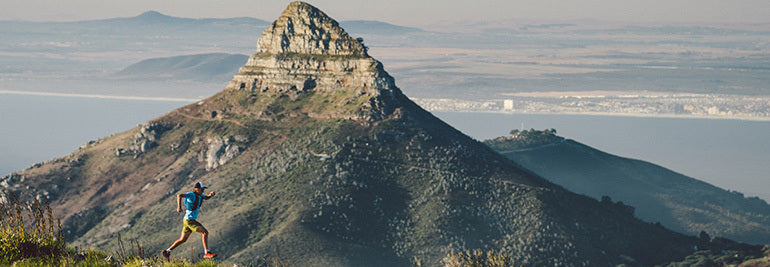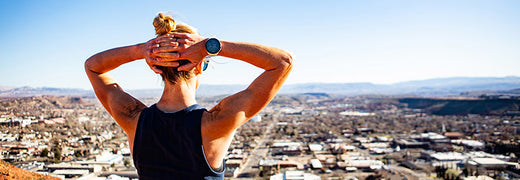

Suunto Blog

Becoming a mother and staying in love with the mountains
New roles for everyone: As Emelie heads out training, Kilian stays home with Maj.
After nine months of pregnancy, resting and recovering after birth, Suunto ambassador Emelie Forsberg is training again in the mountains and fjords of Norway where she and her partner Kilian Jornet live a life filled with adventure.
True to her background in seasonal farming, gardening and eating, Emelie understands well there is a season for everything, and is taking her time to come back to elite mountain running and skiing form.
“I don’t push my boundaries because I prefer to take small steps and to do it really healthy and slow,” she says. “That might mean my way back will be longer, but that’s who I am. I would regret it so much if I took too big a step and got injured. I want to take things slow.”
Watch below and see how Emelie is balancing the joy of being a new mum with finding her legs again as one of the best mountain athletes on the planet.
WATCH "BEING AN ATHLETE AND A NEW MUM"

Ryan Sandes’s new 13 Peaks Challenge and the joy of backyard adventure
© Jared Paisley
The summit of Table Mountain towers 1054 m above Cape Town below. The keystone of Table Mountain National Park, the peak is famous for its biodiversity and incredible panoramic views.
This is Suunto ambassador Ryan Sandes’s home training ground. It’s where he prepares for the ultra marathons he races in around the world. He’s know this terrain like the back of his hand.
“Table Mountain is one of the few places where you can go from the city to the top of a mountain in under an hour,” Ryan says. “There’s something really magical about it and the whole Cape Peninsula – the combination of really technical trails, beautiful landscapes and ocean views.”
© Jared Paisley
After running in locations all over the world – Antarctica, the Gobi Desert, the European Alps, the Himalayas, and the jungle of Central America – Ryan felt called to explore his own home turf more fully. “We so often search far and wide for adventure, when epic backyard adventures are waiting right on our doorstep,” Ryan says. “It doesn’t take a lot to create them; it’s just using your imagination a little bit, and going out and having a good time.
“There is so much potential for backyard adventures, whether it involves surfing, a long distance swim, a kayak paddle, or doing a crazy mountain bike. There’s just so much out there. Even if you live in a massive city, you can still create a fun backyard adventure. The opportunities are endless.”
The 13 Peaks Challenge all started with Ryan sketching a route on a notepad. With pen and pad, he linked up 13 peaks in the park to create a backyard adventure for locals and tourists alike. Then he convinced a friend to run it with him. “I told him it would only be 40 or 50 km,” Ryan says. “It ended up being an epic adventure, over 108 km!”
© Jared Paisley
With that huge day out, the 13 Peaks Challenge was born. The route is 108 km, and includes 6500 m of vertical gain. It can be done in 24 hours, 48 hours or as a multi day challenge. About 20 people have completed it so far. A group of runners is currently attempting to do the 13 peaks in 13 weeks.
Ryan’s friends Ryno Griesel, Ruan van der Merwe, and Jock Green hold the fastest known time (20 hours), but maybe not for long. “In some ways I’m more looking forward to giving that another go than any other races or events,” Ryan says.
People living in Cape Town have caught on to the challenge more quickly than Ryan expected. Enthusiasts are making merchandise for finishers. The challenge is collaborating with charity the Southern Lodestar Foundation to help feed schools in the area. And the people who have completed it are helping those undertaking it. “I’ve been blown away by how many people have become passionate about it,” Ryan says. “It’s become really community orientated. It’s creating camaraderie.”

The benefits of the long run and how to do it right
With a stellar cross-tri career, including being the 2015 XTERRA World Champion, Josiah Middaugh combines his elite competition experience with his university education in sports science to provide cutting-edge coaching to his clients.
Josiah Middaugh is both an endurance coach and a pro athlete.
For endurance athletes, a central component of their training programme is the long run. “Running aerobically past the hour mark, the magic starts to happen at the cellular level, primarily increased capillary density and an increase in the size and number of mitochondria, the aerobic powerhouse of the cell,” Josiah explains. “This lays the foundation so you can achieve better adaptation from your specific race pace training and interval training.”
Long run benefits
Josiah says the list of benefits and adaptations coming from regular long runs is long. Here are his top three.
Efficiency improves as your body more efficiently burns fat at low to moderate intensity
Running economy improves so you are running faster at sub max heart rates.
The strength of your heart also improves resulting in a larger stroke volume and lower resting heart rate.
Common mistake
Athletes commonly believe unless they’re pushing hard, there are no benefits. It’s the “no pain, no gain” mentality. With the long run, slowing down is key. “Most people start too fast and fade,” Josiah says. “Most of your long runs should be easy and it might feel painfully slow if you are new to them.”
7 tips to help you do them right
Keep it aerobic
Aerobic refers to light exercise you can sustain over a long time. “Keep your long runs at least two minutes per mile slower than your current 10k race pace,” Josiah says.
Set a heart rate
“Set a heart rate ceiling for your run,” Josiah says. “Start with a low heart rate and watch it gradually tick up one beat at a time until you are in your target range.” Keep it there.
However, and this is important, don’t base your heart rate on the common age based calculation: heart rate zone minus age. “Age predicted equations will only work for about 20 percent of the population and the margin of error is plus or minus 20 beats,” Josiah says. “That's a 40 beat range!”
Instead, perform a four mile field test to find your functional threshold (FT) heart rate. Find your average heart rate for your best four mile (6.5 km) effort or use a 10k race pace. Check out Josiah’s spreadsheet to help determine heart rate and pace zones.
Consistency over frequency
Many athletes believe they need to do multiple long runs per week. This isn’t the case, Josiah says. Once a week is enough. “It's the consistency over time that makes the difference,” he says. “Results from incorporating a consistent long run can be noticed after about four weeks.”
Increase gradually
The duration and distance of your long run depends on what you are training for. “Progress your long run gradually adding only 10-15 percent per week until you approach your target long run distance,” Josiah says. “If you are training for a marathon or beyond, it might be necessary to undulate the distance of your long run if you are approaching 20 miles and/or three hours.”
5k/10k runners: there is no need to run for more than two hours.Half marathon runners: keep it race distance or less.Marathon runners: gradually build long run distance to just over two-thirds of the race distance, no more than 18-20 miles (29-32 km).
“For most athletes I have a rule of the longest run being no more than around three hours or 20 miles, whichever comes first,” Josiah says. “You have to weigh up the increased risk of injury and length of recovery needed when one runs over about 20 miles.”
Stay fuelled
For the best recovery and adaptations, fuelling before, during and after is important. Start fuelling early into your long run and ensure you’re also getting enough fluids. Fuelling during is especially important for runs 90 min or longer. “Fueling during a workout can improve the performance of that workout, help you recover faster from it, and boost your immunity,” Josiah says. “Shoot for about 200 calories per hour, or about one energy gel every 30 minutes with adequate water – roughly one 20 ounce water bottle (600 ml) per hour.”
Fuel well post run
“Your post-run nutrition is equally important,” Josiah continues. “Attempt to take in a quick 300 calories within 30 minutes of completing your long run with a focus on carbohydrates along with some protein and of course water. The primary goal of recovery nutrition is to restore your muscle and liver glycogen so you can recover faster. Do more with more, not more with less.”
Run in the morning
Morning is almost always a better time of day for your long run. “Elite running coach Joe Vigil advocates a long run early in the morning because you have more fluid in your intervertebral discs,” Josiah says. “Also, you are not yet fatigued from the days activities or from a long day at work. Most races are contested in the morning so it is ideal to set your biorhythms to the time of your next event.”
More running related articles:
7 tips for running hot weather
Learn how sleep can make you a better running
Improve your running with high intensity hill repeats
The lazy runner's guide to a marathon

Dancing across the landscape: the bliss of flow states
© Martina Valmassoi
Running for nearly a full revolution of the Earth brings up a whole palette of emotions and experiences. Elation, pain, resistance, boredom, wonder, blankness – repeat.
Suunto ambassador and Australian ultra runner Lucy Bartholomew has experienced the full range. One of the things that keeps her going are the incredible flow states she has experienced while running against the sun.
“The best way I can describe this feeling is like meditation,” she says. “It’s a state where there is no energy being exhausted and it’s a state of flow where you move, but time feels like it stands still. It’s hard to explain until you find it yourself.”
Lucy is currently preparing for the Western States 100 Mile Endurance Run. In last year's race, she unconsciously entered into a flow state, losing track of time. At one point she thought she had a very long way to go, and then in what seemed like moments later, most of the course was behind her. “It was like I was watching myself dance over the terrain and all I could think was, ‘I could do this all day’,” she says.
© Martina Valmassoi
Lucy’s three rules of flow
You can’t control it
As seductive and blissful as flow states are, Lucy doesn’t expect to experience them. She has no control of when they come and go. When they come, great, when they go, she remains detached. “They are part of the beautiful adventure of running and I just let them come and go as they do; like good moments and bad moments, you realise that nothing last forever,” she says.
Don’t chase it
Having a detached attitude is important because chasing flow states simply chases them away, Lucy says. Being present, happy and calm is her focus, which is the right mental state for a flow state to emerge from. And while she doesn’t chase them, they do support her running performance. “Especially in the longer stuff I think they provide a time where it feels effortless and wonderful,” she explains. “They give you confidence and reassurance that body and mind are comfortable”
Flow is not an excuse to space out
One potential downside of flow states is becoming so thoroughly immersed in the moment that you forget to take care of the basics. “During these moments I tend to forget about fuelling and pacing,” Lucy explains. “I run with blissful unawareness of what’s ahead because it’s all about focusing on the ‘now’. But when that moment passes, the reality of what you have got yourself into can hit you really hard.” While tasting the bliss of flow, make sure you remember to take care of the basics.
Lead images:
© Damien Rosso / Droz Photo
© Martina Valmassoi
Click below to read the articles in our series on flow:
Finding the flow
7 principles to help you find the flow
Follow Red Bull X-Alps 2019 live here!
And they're off! The ninth edition of the world's toughest adventure race, Red Bull X-Alps, has begun! After months of training and preparations, 32 athletes from 20 nations have set off from historic Mozartplatz in Salzburg, Austria, beginning a 1138 km race across the European Alps to the finisher's float in Monaco.
Fans around the world are getting comfortable and locking into the action. Anyone who has followed the previous editions of the race via its state-of-the-art live tracking system knows once you start watching it's difficult to stop; the drama, the obstacles, set backs, competition and break throughs make it almost addictive.
Red Bull X-Alps is a one of a kind race. If it's new to you, you might assume that because it involves paragliding it can't be too tough. Think again. This isn't sunny Saturday afternoon paragliding – it's alpine paragliding; it involves navigating huge mountain chains, glaciers, commericial flight paths. For this reason, only the very best pilots can enter the race.
It also demands next level endurance. The athletes are attempting to hike and fly across the length and breadth of the Alps, checking in at 13 turnpoints along the way. If the weather folds, they will have to hike insane daily distances with massive vertical gain. Each one of them will depend on seasoned outdoor skills.
The live tracking system makes it easy for fans to follow their favorite athletes. With many of the athletes coming from alpine nations, local fans will come out and cheer them on as they pass through their towns and villages. With this edition's route being considered the toughest race yet, this is one race worth tuning into.
Lead image by zooom.at/Red Bull Content Pool
READ MORE
THE SHEER AUDACITY OF RED BULL X-ALPS
CHASING THE EAGLE ACROSS THE ALPS

7 tips for running in hot weather
Ryan is specialist at running in heat. © Graeme Murray / Red Bull Content PoolWhen Ryan Sandes ran across the Sahara Desert in 52°C heat, it felt like he was running with a paper bag on his head. “It doesn't feel like you can get enough air in,” he say. “Everything you breathe is super hot.”
The South African ultra champion competed in the Four Deserts Race, including the Sahara, Gobi, Antarctica, and Atacama deserts, placing first in three, and second in one. He’s also run in the deserts of Madagascar and Namibia, the insane Jungle Marathon in Central America, as well as in 45°C on the epic Western States 100 Miler, where he placed first in 2017. Needless to say, Ryan has learned to handle the heat – here are his seven tips.
“Heat has a huge effect; it makes you a lot more tired, and move slower,” Ryan says. “Mentally, it's also harder. The good news is the body does adapt to heat really well.”
Take every opportunity to cool your core temperature. © Graeme Murray / Red Bull Content Pool
Before race day
Cultivate acceptance
Whatever the challenge, whether struggling with altitude like he did when he and Ryno Griesel set the fastest known time on the Great Himalayan Trail, or enduring intense humidity in the jungle, acceptance is essential for mental toughness, Ryan says. “Running in the heat is not only a physical challenge, but also a mental one,” he says. “You have to accept it and realise it's going to be tougher. It's like running at high altitude; you are going to have the physiological restrictions, and you’ve got to accept that and make peace with it.”
Click to read Ryan's five life lessons he learned on the Great Himalayan Trail
Benefit from simulation
When Ryan prepared for running across the Sahara Desert he trained in an environmental chamber at the Sports Science Institute of Cape Town. He ran on a treadmill in the small room for an hour or two, while coaches adjusted the temperature to match that in the Sahara. “It gave me a lot of confidence that I could run in those temperatures,” he says. “I think a lot of it is about not panicking, being at ease with the fact it is going to be difficult. That training helped a lot.”
Not many of us have access to an environmental chamber. If you don’t, then Ryan recommends having saunas a couple of weeks before your race. “Get into a sauna or steam room daily or every second day and just sit in their or do a couple of light exercises,” he says.
Another way to simulate, is to wait for the afternoon sun, then put on some extra layers of clothing and head out for a run. “Get the body sweating and being more efficient in the heat,” Ryan explains. “You pick it up quite quickly, but you also lose it quite quickly. Just focus on doing this two to three weeks out from the event.”
Have a plan
Before the race or training session, create a plan for how to keep yourself hydrated and as cool as possible. Think carefully about how much water you need to carry, where on the route you will be able to refill your water supply, and also when you might be able to cool yourself down. “Try to figure out how much water and electrolytes you need in your training,” Ryan says.
During the race
Regular water stops
“At the Western States 100 Miler there are a lot of aid stations long the way,” Ryan says. “Take some extra time at aid stations to make sure you are getting in enough liquids and electrolytes. While you’re there, use ice, or cold sponges, or an ice hat if you have one.”
Stay cool
Ryan recommends wearing an ice hat, or ice neck and wrist wraps to help stay cool. When you pass by a stream or lake, take a dip whenever you can. Another trick is to wear light weight attire made of fabrics that hold some moisture. As you run and the air passes through the fabric, the moisture will cool. “When your core temperature gets too high it slows you down,” he says. “If you can control that it’s a big help.”
Take electrolytes
“Don’t drink too much water without replenishing your electrolytes,” Ryan says. “Different people sweat out different amounts. The more you get used to running in the heat and the sun, the more efficient you become in how much you sweat and your electrolyte use.”
Protect yourself
A hat, sun glasses, sunscreen and lip balms are all essential items to protect yourself from the sun. “If you get sunburn early on that can be the end of the long run,” Ryan says. “When you sweat a lot, you chaff a lot more so I also use Squirrel’s Nut Butter underneath my armpits, on my nipples, and around my groin.”
Lead image: © Graeme Murray / Red Bull Content Pool
Click below for more running tips!
Learn how sleep can make you a better runner
7 principles to help you find the flow
Improve your running with high intensity hill repeats
The lazy runner's guide to a marathon














































































